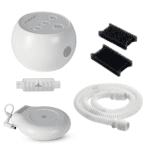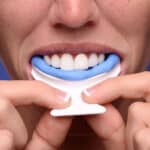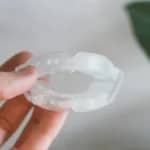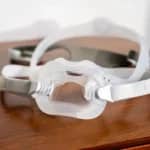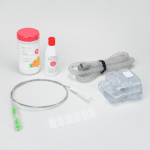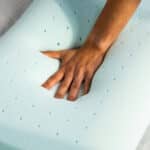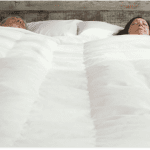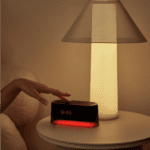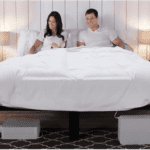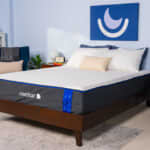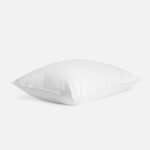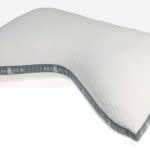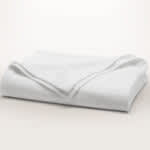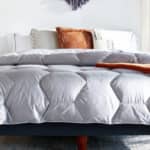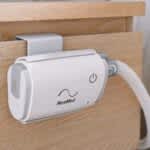A plush mattress is on the softer end of the firmness scale. The term is often used for sleep surfaces with a medium soft (4) feel or softer. However, it can also refer to firmer models with highly conforming comfort systems. Firmness is a key point to assess when choosing a mattress because finding the right balance enhances comfort and improves posture.
The defining characteristic of a plush mattress is that a sleeper sinks in. While this can relieve pressure and provide a comfortable hug, an overly plush mattress can jeopardize your spinal alignment. As a result, plush mattresses are usually best for side sleepers, especially those under 130 pounds.
We’ll explain the characteristics of plush mattresses to help you decide if they’re right for you.
How Does It Feel to Sleep on a Plush Mattress?
Sleeping on a plush mattress often feels like the mattress is cradling you closely. Because of this, some describe the best soft mattresses as cloud-like. You can also use a mattress topper to soften your bed’s surface for a similar effect.
Plush mattresses let sleepers sink in, redistributing their body weight to limit pressure buildup from areas that commonly press against a mattress, like the hips and shoulders. Our testers who experience pressure-related aches and pains often report that a plusher surface reduces discomfort as long as they still get the support they need. We also typically detect very minimal motion transfer on plush surfaces, so plush beds can be great if you wake up easily when your partner moves.
However, plush mattresses do have some potential drawbacks. Since they hug the body, they’re often more difficult to move on and trap more body heat, so they’re not the best for active sleepers or hot sleepers. Additionally, a mattress that’s too plush for your sleep position or body type could make it hard to maintain your spinal alignment, potentially contributing to muscle tension and lower back discomfort.
Who Should Sleep on a Plush Mattress?
You may want a plush mattress if you sleep on your side, you have a lighter build, or you have sore spots that are made worse by pressing against a mattress.
Plush models are often among the best mattresses for side sleepers, particularly sleepers under 130 pounds. Some sleepers under 130 pounds who prefer other positions also find plush mattresses comfortable, as do some individuals with chronic pain. However, for optimal comfort, it’s critical to find a mattress that’s plush enough to contour closely without sacrificing support. This typically involves selecting your mattress firmness based on your body type and sleep position.
Who Should Not Sleep on a Plush Mattress?
We don’t generally recommend plush mattresses for most stomach sleepers, individuals over 230 pounds, hot sleepers, or anyone with mobility issues.
Between firm and soft mattresses, firmer is usually much better for stomach sleepers. Stomach sleepers often experience lumbar discomfort when their midsections sink more deeply into a mattress than the rest of their body. The best way to prevent this is a firmer mattress. Sleepers over 230 pounds are also unlikely to get sufficient support from a plush sleep surface. Additionally, the hug of a plush model may trap too much body warmth for people who are prone to overheating, and it may impair movement for sleepers with mobility issues.
How to Determine the Right Mattress Firmness for You
The best mattress firmness for you depends largely on your body type and sleep position. While plush mattresses suit certain sleepers, they can be uncomfortable for others. A comfortable mattress may improve sleep quality. In turn, sleep quality has far-reaching impacts on physical health, mental health, and occupational performance.
To quantify mattress firmness, we use a 10-point firmness scale. Softer, plusher models fall at the lower end of the scale, whereas firmer options have higher numerical ratings. Plush beds typically have a rating of extra soft (1), soft (2 to 3), or medium soft (4).
Here’s a breakdown of the average best firmnesses based on your body type and sleep position:
| Under 130 lbs. | 130 to 230 lbs. | Over 230 lbs. | |
|---|---|---|---|
| Side Sleepers | Soft (3) to Medium (5) | Medium Soft (4) to Medium (5) | Medium Firm (6) to Firm (7) |
| Back Sleepers | Soft (3) to Medium (5) | Medium (5) to Firm (7) | Firm (7-8) to Extra Firm (9) |
| Stomach Sleepers | Medium Soft (4) to Medium Firm (6) | Medium (5) to Firm (7) | Firm (7-8) to Extra Firm (9) |
The Sleep Doctor Forum: Real Experiences, Real Connections
Continue the discussion on the Sleep Doctor Forum. Connect with experts and fellow forum members on CPAP, sleep apnea, and all things sleep. A priceless resource that’s free to join.


